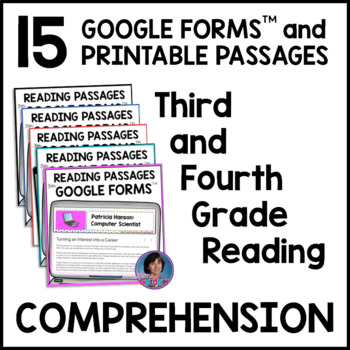3rd & 4th Grade Reading Comprehension Passage Bundle: Google Forms™ + Slides™
- Zip
- Easel Activity

What educators are saying
Products in this Bundle (3)
Description
Digital Reading Comprehension Passages for use with Google Forms™ featuring Career Paths
This reading comprehension packet is designed to help kids work toward the goals of reading, comprehending and thoughtfully responding to Guided Reading Levels O and P text.
The high-interest topics make these passages ideal for use in distance learning.
To provide flexibility, for use in distance learning and/or a classroom setting, the following options are offered:
1) A Google Form for each of the 15 reading passages in this series
2) Ready for use with the new TpT Digital Tool
3) A link to this document in Google Slides
4) A printable PDF
This file includes 15 passages. There are two pages of questions with each passage. The first page includes five text-based multiple choice questions. The second page is comprised of two written response questions.
The following passages are included in this pack:
★ Henry's Landscaping and Lawn Services
★ Breaking News: Life As A Reporter
★ Patricia Hanson: Computer Scientist
★ An Author’s Life: Vision and Revision
★ Cole Raftis: Real Estate Agent
★ Ben Swanson: Yellowstone Tour Guide
★ Building A Career As A Mason
★ Architecture: The Intersection of Science, Engineering, and Art
★ A Day in the Life of John Williams: X-Ray Technician
★ Simon Mills: Solar Power Enthusiast and Entrepreneur
★ Mandy Michaels: Mechanical Engineer
★ Catering: So Much More than Meets the Eye!
★ Lena Hutchinson: Soccer Player
★ The Pharmacist: A Vital Part of the Healthcare Team
★ Ikigai – A Key to Success?
Thanks so much for stopping by and taking a look!
Sincerely, Anne Gardner (National Board Certified in Literacy)
******************************************************************************************************
Each resource in this bundle is also available separately. Click the smaller images below the bundle cover to view individual resources.





